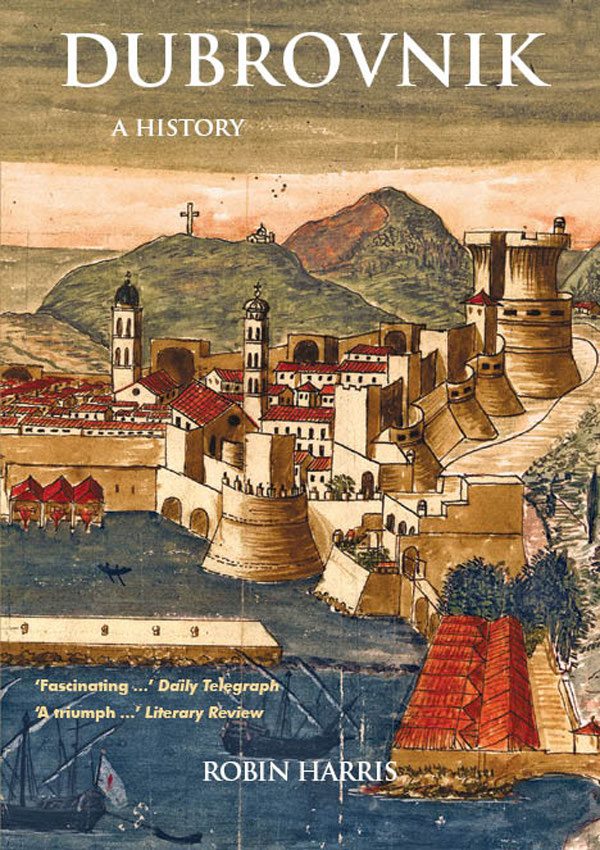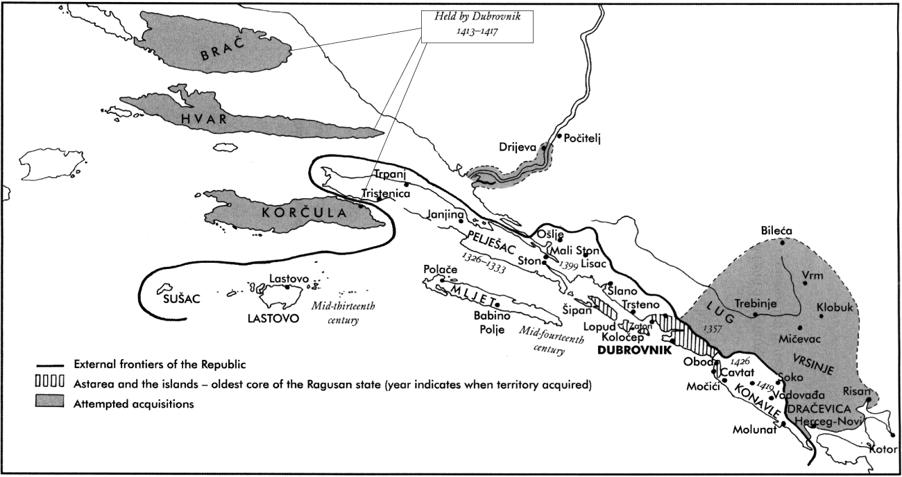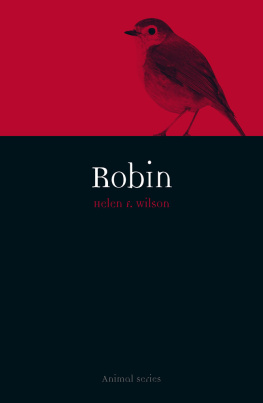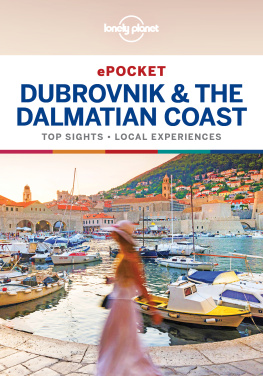Robin Harris - Dubrovnik: A History
Here you can read online Robin Harris - Dubrovnik: A History full text of the book (entire story) in english for free. Download pdf and epub, get meaning, cover and reviews about this ebook. year: 2006, publisher: Saqi Books, genre: Religion. Description of the work, (preface) as well as reviews are available. Best literature library LitArk.com created for fans of good reading and offers a wide selection of genres:
Romance novel
Science fiction
Adventure
Detective
Science
History
Home and family
Prose
Art
Politics
Computer
Non-fiction
Religion
Business
Children
Humor
Choose a favorite category and find really read worthwhile books. Enjoy immersion in the world of imagination, feel the emotions of the characters or learn something new for yourself, make an fascinating discovery.
- Book:Dubrovnik: A History
- Author:
- Publisher:Saqi Books
- Genre:
- Year:2006
- Rating:3 / 5
- Favourites:Add to favourites
- Your mark:
- 60
- 1
- 2
- 3
- 4
- 5
Dubrovnik: A History: summary, description and annotation
We offer to read an annotation, description, summary or preface (depends on what the author of the book "Dubrovnik: A History" wrote himself). If you haven't found the necessary information about the book — write in the comments, we will try to find it.
Dubrovnik: A History — read online for free the complete book (whole text) full work
Below is the text of the book, divided by pages. System saving the place of the last page read, allows you to conveniently read the book "Dubrovnik: A History" online for free, without having to search again every time where you left off. Put a bookmark, and you can go to the page where you finished reading at any time.
Font size:
Interval:
Bookmark:


Detailed, scholarly and eminently readable, Dubrovnik is a triumph of book production. This is a splendid volume.
Literary Review
There are few introductions to the citys past available to general readers ... Harriss splendid study meets this need admirably.
TLS
Learned, fluently written and lavishly illustrated.
The Sunday Telegraph
A fascinating and scholarly account ... a learned and well-written labour of love.
The Daily Telegraph
Harris tells the whole story more faithfully than any previous English historian has done. A triumph, indeed, to set beside those of the great journalists.
Michael Foot, Tribune
Harris offers up an intense look at a curious world. Truly fascinating.
Good Book Guide
Unravelling the complex history of Dubrovnik takes skills of a high order, and Robin Harris has these.
Professor Norman Stone
Splendid ... the book about Dubrovnik we have all been waiting for.
Dr Noel Malcolm
Robin Harris has written a splendid and discerning history of Croatias Adriatic pearl.
Professor Ivo Banac, Yale University

Territory of the Ragusan Republic
ROBIN HARRIS
DUBROVNIK
A HISTORY
SAQI
British Library Cataloguing-in-Publication Data
A catalogue record for this book is available from the British Library
ISBN: 9780863566097
EAN 9-780863-569593
First published in hardback in 2003 by Saqi Books, London
This edition published in 2006
copyright Robin Harris, 2003 and 2006
The right of Robin Harris to be identified as the author of this work has been asserted by him in accordance with the Copyright, Designs and Patents Act of 1988
All rights reserved. No part of this book may be reproduced or transmitted in any form or by any means, electronic or mechanical, including photocopying, recording or by any information storage and retrieval system, without permission in writing from the publisher.
This book is sold subject to the condition that it shall not, by way of trade or otherwise, be lent, re-sold, hired out, or otherwise circulated without the publishers prior consent in any form of binding or cover other than that in which it is published and without a similar condition including this condition being imposed on the subsequent purchaser.
SAQI
26 Westbourne Grove
London W2 5RH
www.saqibooks.com
SECTION ONE
SECTION TWO
SECTION THREE
SECTION FOUR
SECTION FIVE
SECTION SIX
The history of the Ragusan Republic can be told in considerable detail because it is so well documented in the Dubrovnik Archives, which contain some 7,000 volumes of documents and about 100,000 separata. As the eighteenth-century French consul there, Andr-Alexandre Le Maire, noted with pardonable exaggeration: The archives of the town are perhaps those of all Europe which are the best conserved and which go back furthest.1
Indeed, so extensive is the information that they contain that those archives also provide insights into the history of other states such as medieval Serbia whose traces would otherwise be largely lacking.
In the preparation of this study I made only limited direct use of that manuscript material. Many of the key documents have already been published in the series listed in the bibliography. Those manuscript documents to which reference is made in the text were chosen mainly for illustrative purposes or to elaborate in more detail a point contained in secondary sources. In any case, what this book seeks to do is something different from the various excellent monographs on which it draws. Its purpose is to bring together the conclusions of the best available scholarship, most of which are inaccessible to those unable to read Serbian or Croatian, and then to provide a clear, critical and readable synthesis. The reader must judge for himself whether that has actually been accomplished.
To the extent that it has, much of the credit should go a number of individuals and institutions without whose help the task would have proved quite impossible. In London I benefited from the resources of the British Library and the Library of the School of Slavonic and East European Studies. In Zagreb I was helped by the staff of the spanking new National and University Library (Nacionalna i sveuilina knjinica). In Dubrovnik I received invaluable advice and assistance both at the State Archives (Dravni arhiv) from its (now former) director Ivan Musta, from Ante olji, from Ivana Lazarevi and from their colleagues. At the Dubrovnik Institute for Historical Science of the Croatian Academy of Arts and Sciences (Zavod za povijesne znanosti hrvatske akademije znanosti i umjetnosti), I was offered advice and assistance by the director Nenad Vekari and his colleague Stjepan osi. Pater Mijo Horvat allowed me to consult the work of Crijevi (Cerva) in the Dominican friarys library the latters must, dust and bullet-indented shutters reminding the researcher of things old and new. Fra Marijo iki made available the work of Matijaevi (Mattei) stored in the Franciscans library still disabled by damage incurred during the fighting a decade ago.
My time in Dubrovnik was made infinitely more agreeable by the generous hospitality of Andrija Kojakovi and of Marija Kojakovi and by the kindness of many others. I also benefited from discussions with Pave Brailo, Slavica Stojan and the director of the City Museum, Mio ura, who helped me obtain material for illustrations used in this book. (Others appear thanks to the co-operation of the State Archives.)
Perhaps the single greatest difficulty in writing such a book as this in the time available after (quite unconnectedly) trying to earn a living is that, no matter how fascinating the subject matter, one can risk losing heart. Among those who ensured by their interest that this did not happen I would mention Ivo Banac, Jadranka Beresford-Peirse, Chris Cvii, Miroslav Kovai, Norman Stone and Mike Shaw. And Nile Gardiner generously gave of his time in preparing the final text.
Two people, though, had a special role. Branko Franoli enthused, advised and guided me along the way: without him I would not have reached my goal. I am also enormously grateful to Noel Malcolm who read the manuscript, offered many helpful suggestions and provided as he does for all those writing on these subjects a gold standard against which to measure achievement.
Finally, I am delighted to acknowledge the help of the Croatian Ministry of Culture; INA; The Luki Group and Karlovaka pivovara; and Vartex Textiles Ltd. in ensuring that this book appears in such good shape.
Both personal and place names in Dubrovnik and elsewhere in Southeast Europe are subject to many variants reflecting political change and cultural mixture. The great families of Dubrovnik had both Italian and Croatian variants of their names. Scholars have chosen one or the other form or even the Latin version that most often appears in official documents. All these options are equally valid, and none is absolutely so. I have used the Slavic form throughout, simply because that is the one most commonly found in the historiography.1 No other significance is implied. The most important Italian/Slavic alternatives are as follows:2
Font size:
Interval:
Bookmark:
Similar books «Dubrovnik: A History»
Look at similar books to Dubrovnik: A History. We have selected literature similar in name and meaning in the hope of providing readers with more options to find new, interesting, not yet read works.
Discussion, reviews of the book Dubrovnik: A History and just readers' own opinions. Leave your comments, write what you think about the work, its meaning or the main characters. Specify what exactly you liked and what you didn't like, and why you think so.










